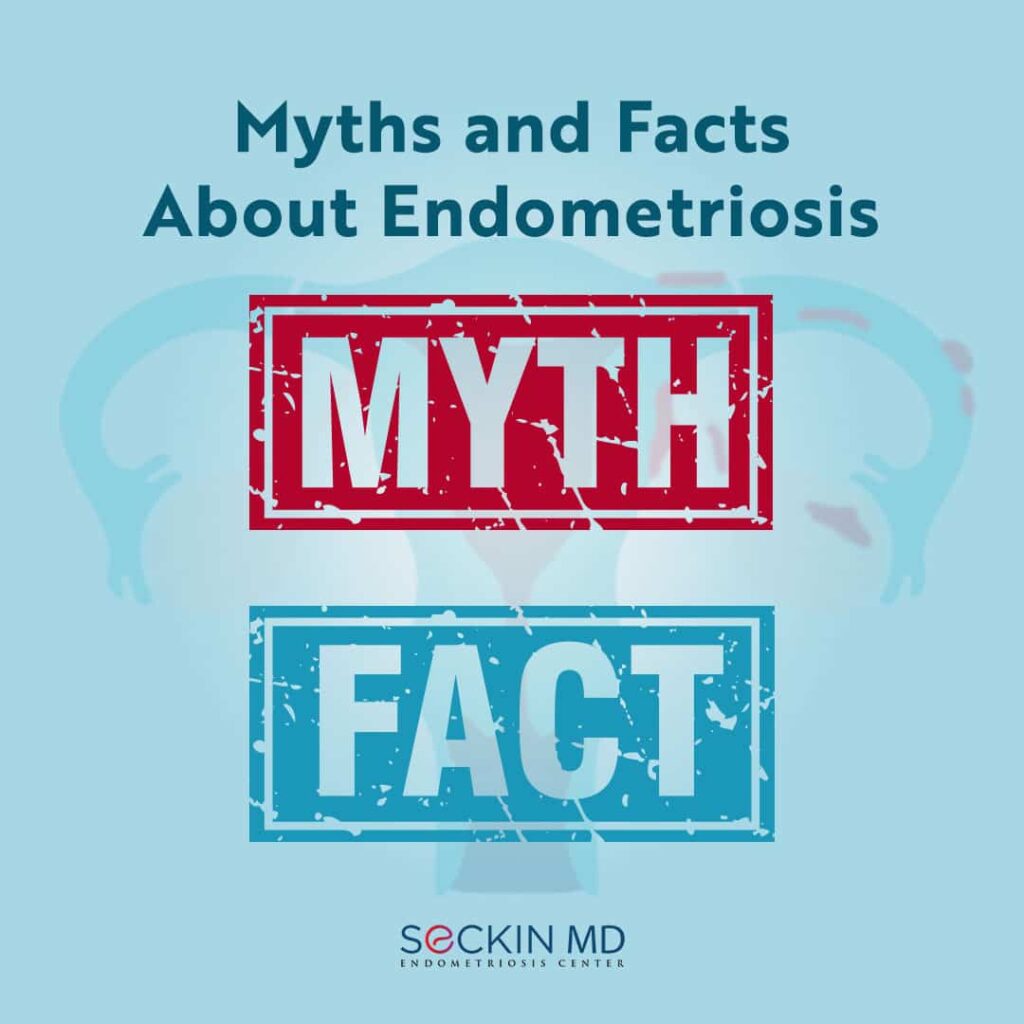Myths and Facts About Endometriosis

Although endometriosis affects around 10% of women of reproductive age, many doctors still do not fully understand the disease. This means that a lot of women go undiagnosed or misdiagnosed. Let’s bust a few myths and facts about endometriosis.
1. It is normal to have extremely painful periods
Myth! While it is normal to have some level of cramping and pain during periods, debilitating pain is an indication that things are not alright. If your period pain is preventing you from going to school or work, you should see a doctor as soon as possible.
2. More pain means more advanced disease
Myth! The severity of your symptoms does not necessarily correlate with the stage of your disease, as defined by the American Society for Reproductive Medicine (ASRM).
At Seckin Endometriosis Center we also use a descriptive classification of the disease. These is peritoneal endometriosis, ovarian endometriosis, and deep infiltrating endometriosis (DIE) with or without multi-organ disease.
3. Adolescents cannot have endometriosis
Myth! Girls as young as 7 can have endometriosis. However, diagnosing the disease in adolescents and young women is especially challenging. Many can be treated presumptively and the earlier that there is clinical suspicion of this disease, the easier it is to manage and prevent the later consequences of the disease.
4. Endometriosis symptoms disappear after menopause
Myth! Endometriosis is an estrogen-dependent disease. While symptoms may improve after menopause, the ovaries continue to secrete small amounts of estrogen hormone so it is possible for existing extraneous endometriosis tissue to respond to this estrogen. Moreover, the ovaries are not the only source of estrogen in the body.
If found, post-menopausal endometriosis implants can be removed using techniques of excision surgery.
5. The cause of endometriosis is not known
Fact! The exact cause of endometriosis is not fully clear. Doctors think that many factors such as genetics, inflammation at the site of lesions, retrograde menstruation, oxidative stress, stem cells, uterine abnormalities, or a combination of these may cause endometriosis.
6. Pregnancy and breastfeeding can cure endometriosis
Myth! Unfortunately, although many doctors still tell their patients that their endometriosis will go away if they get pregnant, this is not true. Endometriosis is a disease with no known cure. Pregnancy results in a reduction in estrogen levels and an increase in progesterone levels and therefore may reduce the symptoms of endometriosis, but it will not cure the disease. There is often a return of symptoms after birth or after cessation of breastfeeding.
7. Endometriosis can affects lots of different organs
Fact! Endometriosis can also occur outside the reproductive system. Some of the other areas where endometriosis lesions can spread include the ureter, bladder, kidneys, bowel, diaphragm, appendix, pancreas, and even lungs.
8. If you have endometriosis, you will be infertile
Myth! Even though infertility is associated with endometriosis, many women with the disease can conceive naturally. Treating the disease early while preserving organ function can maximize a woman’s chance of success.
9. Hysterectomy can cure endometriosis
Myth! Hysterectomy, or the removal of the uterus, results in surgical infertility. Though often wrongly advocated by doctors upon endometriosis diagnosis, it does not cure endometriosis. Endometrial lesions can also occur outside the uterus and so a hysterectomy may not even alleviate the symptoms of the disease.
At Seckin Endometriosis Center, we perform hysterectomy only as a last resort when all other options have failed and the patient has given full consent.
10. Endometriosis can be managed with hormonal treatments
Fact! It is true that hormonal treatments can help manage the symptoms of endometriosis. It is important to note that this is only a way to manage the disease not to treat it. Hormonal treatment alone does not fully address the underlying cause of the disease.
11. I will need multiple surgeries
Myth! If you have the appropriate surgery, you may not need more than one surgery to treat your endometriosis. Endometriosis pain, progression, and goals for quality of life varies significantly among reproductive-aged females.
Moreover, even though the disease can recur after surgery, there are ways to minimize this risk. For example, thanks to our patented Aqua Blue Contrast (ABC)TM technique, the surgeons at Seckin Endometriosis Center are able to clearly visualize and remove even the smallest of endometriosis lesions providing longer lasting relief and minimizing the risk of disease recurrence.
Did you believe any of the above myths or were you misled by someone to think they were facts? Please leave a comment on our post on Facebook or Instagram
Get a Second Opinion
Our endometriosis specialists are dedicated to providing patients with expert care. Whether you have been diagnosed or are looking to find a doctor, they are ready to help.Our office is located on 872 Fifth Avenue New York, NY 10065.
You may call us at (646) 960-3080 or have your case reviewed by clicking here.